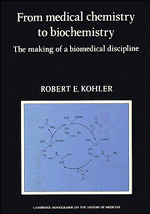Book contents
- Frontmatter
- Contents
- 1 Introduction: On discipline history
- 2 Physiological chemistry in Germany, 1840–1900
- 3 Physiology and British biochemists, 1890–1920
- 4 General biochemistry: the Cambridge school
- 5 European ideals and American realities, 1870–1900
- 6 The reform of medical education in America
- 7 From medical chemistry to biochemistry: the emergence of a discipline
- 8 Unity in diversity: the American Society of Biological Chemists
- 9 The clinical connection: biochemistry as applied science
- 10 Chemical ideals and biochemical practice
- 11 Biological programs
- 12 Epilogue: Toward a molecular biology?
- Location of archival sources and abbreviations
- Notes
- Index
7 - From medical chemistry to biochemistry: the emergence of a discipline
Published online by Cambridge University Press: 07 October 2011
- Frontmatter
- Contents
- 1 Introduction: On discipline history
- 2 Physiological chemistry in Germany, 1840–1900
- 3 Physiology and British biochemists, 1890–1920
- 4 General biochemistry: the Cambridge school
- 5 European ideals and American realities, 1870–1900
- 6 The reform of medical education in America
- 7 From medical chemistry to biochemistry: the emergence of a discipline
- 8 Unity in diversity: the American Society of Biological Chemists
- 9 The clinical connection: biochemistry as applied science
- 10 Chemical ideals and biochemical practice
- 11 Biological programs
- 12 Epilogue: Toward a molecular biology?
- Location of archival sources and abbreviations
- Notes
- Index
Summary
The reorganization of medical institutions created opportunities for growth and innovation in all the preclinical disciplines. Because the reform movement emphasized intellectual quality and uniform standards, competition for regional or national leadership became a powerful argument for higher budgets. Discipline builders were liberated from local medical politics. Workers in all disciplines were encouraged to acquire specialized academic credentials and to engage in fashionable lines of research. Each discipline adapted these new resources to its particular needs, but the basic strategies are similar in all.
As universities gained control of the preclinical sciences, they established academic criteria for appointments and promotion. The AMA Council on Education in 1909 was unanimous and vehement in their opinion that physiology and biochemistry should be taught by full-time specialists: “The old but still prevalent idea that almost any young practitioner with time on his hands could do as professor of physiology cannot be too forcibly condemned.”
More sophisticated medical students made it possible for anatomists, physiologists, and biochemists to teach more specialized courses and to teach them as basic experimental sciences. The new professionals had much higher expectations than the pioneers. For example, Henry Pickering Bowditch had had to bootleg laboratory instruction into his lectures on medical physiology; his disciple, William T. Porter, saw lectures and medical application as incidental to pure experimental physiology. Here is the difference between the generations: what had been academic frosting for the pioneers was cake for the new professionals. Research achievement became as important as teaching skills in building the reputation of a school.
- Type
- Chapter
- Information
- From Medical Chemistry to BiochemistryThe Making of a Biomedical Discipline, pp. 158 - 193Publisher: Cambridge University PressPrint publication year: 1982



